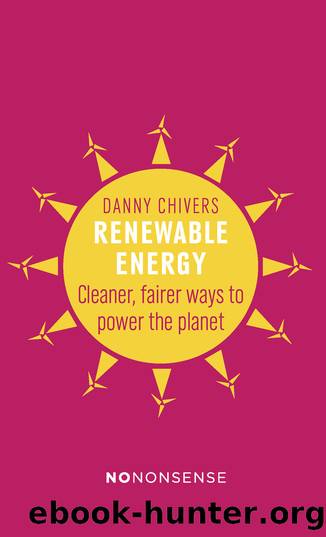NoNonsense Renewable Energy by Danny Chivers

Author:Danny Chivers [Chivers, Danny]
Language: eng
Format: epub
ISBN: 9781780262444
Publisher: New Internationalist
Costs, risks and drawbacks
While fuel crops are ‘renewable’ in theory – you grow them, you burn them, you grow some more – in practice they have one very real and very important limitation. They need land, and lots of it.
The possible exception to this is fuels made from agricultural waste and used cooking oil. We’ll look at these in more detail in Chapter 7, so for now let’s focus on fuel made from purpose-grown energy crops (which makes up the great majority of biofuels, as we’ve seen).
The ‘first generation’ biofuels made from food crops need good, farm-quality soils. The problem is, the world’s productive land tends to have things already on it: farms, or forests, or swamps and deltas rich in biodiversity. Growing fuel crops usually means either switching farmland over from feeding people to feeding cars, or destroying woodlands, rainforests and marshlands that not only act as plant and animal habitats but also as important stores of carbon and, often, as a source of food and fuel for local people.
Current ethanol and biodiesel fuel production uses an estimated 45 million hectares of farmland,* enough to feed almost half a billion people.14 At least 17 million hectares of land have been seized from local communities in Africa, Asia, Latin America and Eastern Europe since 2002, and turned over to biofuel production.15 This has forced countless farmers off their land and into poverty and hunger. Elsewhere, the biofuel industry provides support for slave-labor-style sugar-cane plantations in Brazil16 and deforestation fuelled by soya plantations in Argentina and palm oil in Indonesia.
Switching any farmland over to fuel production means there’s less land available for food; this pushes up the price of food and creates more demand for farmland elsewhere, which has all kinds of knock-on effects. The use of biofuels is thought to have played a significant role in the recent spikes in global food prices (along with food speculation, more meat-heavy diets and the impacts of climate change).17 The US, as the world’s biggest exporter of corn, is seen as a particular culprit here.
There’s also a big question mark over the climate benefits of using fuel crops. Once the greenhouse gases from the fertilizers, farm energy, refining and transport of the fuels are taken into account, ethanol and biodiesel are far from zero carbon. Then we need to add in the carbon dioxide from ‘Indirect Land Use Change’ (ILUC). Switching a piece of food-growing farmland over to biofuels means that someone elsewhere will need to grow some extra food to compensate – and they may well be felling a forest or carving up peatland to do it. This leads to sizeable ‘indirect’ carbon emissions – see Chapter 8 for more details.
Download
This site does not store any files on its server. We only index and link to content provided by other sites. Please contact the content providers to delete copyright contents if any and email us, we'll remove relevant links or contents immediately.
| Automotive | Engineering |
| Transportation |
Whiskies Galore by Ian Buxton(40304)
Introduction to Aircraft Design (Cambridge Aerospace Series) by John P. Fielding(32332)
Small Unmanned Fixed-wing Aircraft Design by Andrew J. Keane Andras Sobester James P. Scanlan & András Sóbester & James P. Scanlan(32137)
Craft Beer for the Homebrewer by Michael Agnew(17440)
Turbulence by E. J. Noyes(7033)
The Complete Stick Figure Physics Tutorials by Allen Sarah(6632)
Kaplan MCAT General Chemistry Review by Kaplan(6045)
The Thirst by Nesbo Jo(5779)
Bad Blood by John Carreyrou(5763)
Learning SQL by Alan Beaulieu(5400)
Weapons of Math Destruction by Cathy O'Neil(5032)
Man-made Catastrophes and Risk Information Concealment by Dmitry Chernov & Didier Sornette(4731)
iGen by Jean M. Twenge(4695)
Digital Minimalism by Cal Newport;(4512)
Life 3.0: Being Human in the Age of Artificial Intelligence by Tegmark Max(4496)
Audition by Ryu Murakami(4093)
1,001 ASVAB Practice Questions For Dummies by Powers Rod(4034)
Electronic Devices & Circuits by Jacob Millman & Christos C. Halkias(4021)
Pale Blue Dot by Carl Sagan(3997)
